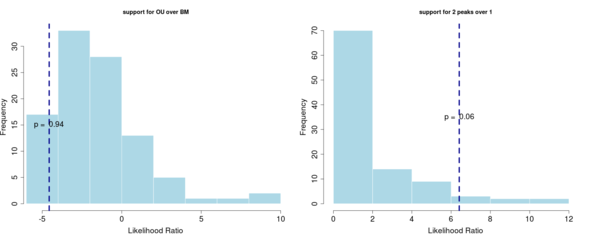- Exploring the cetartiodactyle data (unreleased)
- Nelder-Mead fails to converge or improve upon the hansen model. Likelihood scores differ little:
> bm@loglik
[1] -362.6228
> ou1@loglik
[1] -364.9039
> ws1$loglik
[1] -362.7616
> ou2@loglik
[1] -361.6976
> ws2$loglik
[1] -361.2542See Cetaceans code.


Fig. 1 The Brownian Motion model is preferred to the OU.1 model (left). Two separate optima are supported over a single optima (right).
This shows the complementary conclusion to the Labrid data-set – While there is support for separate regimes between the cetaceans and artiodactyles, the differences in likelihood are adequately explained by differences in the selective optimum location for each regime, and do not support different strengths of selection (alpha) or different rates of evolution (sigma). This comparison isn’t directly shown through bootstrap likelihood ratio as it is already clear since the likelihood score of the two-peak model matches the nested, simpler ou2 model from ouch/hansen method that only lets optima positions differ.
It is possible this is due to a likelihood ridge frustrating the algorithm, as the full wrightscape model is seeded using the values from ou2 for alpha and sigma, though some further exploration with initial conditions does not seem to bear this out.
Code & algorithm
- Nelder-Mead set to 20000 iterations is a bit ambitious, usually converges in under 500 or never converges.